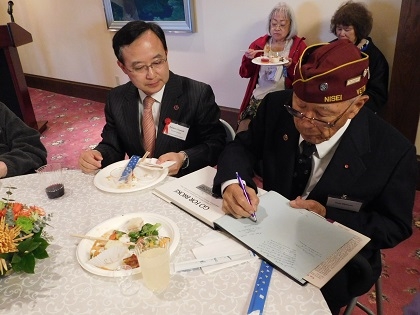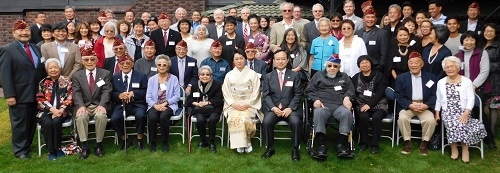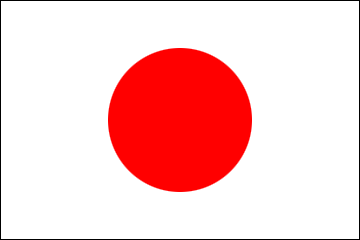Through the Eyes of the former Consul General Yamada (June, 2017 - July, 2020)

The 442nd Infantry Regiment
November 11 is Veteran’s Day, a national holiday in the United States. In Seattle, there is an organization for Japanese American veterans known as the Nisei Veterans Committee*. As I wrote in my previous entry, during World War II, about 120,000 Japanese Americans were forcibly relocated to internment camps until the end of the war, labeled as “enemy aliens” just because of their Japanese ancestry.
A majority of the incarcerated youth voluntarily enlisted in the U.S. military service during the war. These individuals formed the 442nd Infantry Regiment, solely made up of Japanese Americans, excluding commanders, and fiercely fought against Nazi Germany on the European front. While the 442nd Infantry Regiment suffered huge losses, they provided relief to U.S. Army Corps who were besieged by the Germans and were on the verge of elimination. The regiment eventually became the most decorated in U.S. military history. A fact that not many from Japan know is that the Regiment liberated prisoners from the Dachau Concentration Camp. In addition to the soldiers’ brave efforts in the European Theatre, the highly-proficient Japanese-speaking youth were employed by the U.S. Military Intelligence Service (MIS) in the Pacific War against the Imperial Japanese Army, and after the war, served an important position as interpreters and translators during the country’s occupation of Japan. The irony of history is that at the same time in 1945, these soldiers’ families were secluded in internment camps located in the remote areas of the United States.
The Japanese American soldiers proved their patriotism and loyalty, only to return home with no property or occupation to their name; they had to rebuild their lives from square one. In Washington State, where prejudice and discrimination still lingered after the war, these men were denied membership to the Military Veterans Association that consisted of U.S. military recruitment soldiers. Because of this exclusion, they created the Nisei Veterans Committee (NVC), a mutual aid organization, of which I previously I mentioned.
Since coming to Seattle, I have become interested in the historical role Japanese Americans and NVC have played. As I assumed my position as Consul General on June 2nd, I just missed their annual Memorial Day ceremony and it had weighed on my mind. In July, I visited NVC Memorial Hall where I learned about the 442nd Infantry Regiment and the Nisei Veterans’ many contributions. I offered flowers to the Nisei War Memorial Monument at Lake View Cemetery in Seattle and visited Bainbridge Island’s Japanese American Exclusion Memorial where Japanese Americans were first detained in the country. At the ceremony for the 75th Remembrance of Puyallup Assembly Center on September 2nd, I learned valuable lessons from Japanese Americans on how they remember history and convey it to the next generation. Thereby, I approached NVC, called upon its members, and held a reception in their honor on September 30th at my official residence.

We were honored with the attendance of Japanese American veterans who served in World War II, the Korean War, the Vietnam War, the Invasion of Grenada, and the Gulf and Iraq War, joined by their families to make a reception of 80 people. Of special note, Mr. Ed Horikawa, Mr. Frank Nishimura, Mr. Tosh Okamoto, and Mr. Tosh Tokunaga - members of the 442nd Infantry Regiment – and their families, attended. There is a memorial book about the 442nd Infantry Regiment titled “Go for Broke” which was the motto by Japanese American soldiers during the war. I received the first edition signed by these four veterans. I take this opportunity to once again extend my deep appreciation to NVC Commander Bryan Takeuchi who gave a speech, 442nd Infantry Regiment veteran Mr. Tosh Okamoto who gave a toast and Mr. Dale Kaku who arranged to have the members attend that afternoon.
Japanese Americans endured incarceration during wartime, exhibited loyalty to the United States through harsh campaigns, rebuilt their lives by working sincerely after the war, and overcame discrimination and prejudice. Their earnest, positive attitude is the foundation for the trust and friendship that the general American people extend to Japan today. It is thanks to the contributions of such Japanese Americans that there currently is a solid Japan-U.S. relationship.
At the same time, the impact of Japan’s attack on Pearl Harbor was one that toppled all aspects of their lives. Therefore, while many Japanese Americans felt an identity to Japanese culture, not everyone found it easy to completely accept the relationship the United States built with Japan, even after the war’s end and Japan’s succeeding democratization.
At Seattle Rotary Club’s weekly luncheon that was on November 8th, just before Veterans’ Day, Mr. Dale Kaku was invited to speak on the 442nd Regiment and the incarceration of Japanese Americans with Ms. Lori Matsukawa. All the 250-plus members attending the luncheon stood up to salute them after the talk. I believe the important role and complex emotions that Japanese Americans have are not fully recognized in Japan. I am committed to do my best to share this important information with as many Japanese as possible.

*Though the term Nisei refers to second-generation Japanese Americans, NVC has continued to represent not just the second-generation that fought in WWII, but all Japanese Americans who served their country.
